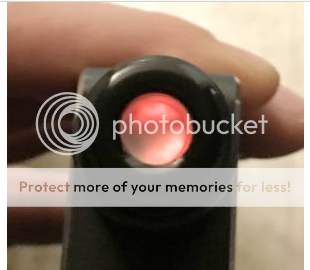OF
Well-Known Member
Are you sure about that? When I was testing TCRs with my IR thermometer, I found that 300-400 was running a lot hotter than the 235-255 suggested range.
You are correct. Think about it a minute. That factor is 'how many percent does the resistance change per degree'. With some 'decimal point shifting' thrown in to keep it from being too easy. Normally this sort of value is expressed in PPM (Parts Per Million), 1/10,000th of a percent. But the real numbers are more like 2450 PPM per degree C. So to save memory and display space, they drop the units and call the value 245. About 1/4 of one percent.
We want to go, roughly, from 20C to 200C? A 180C rise. Times .00245 (.245%) gives us a delta (change) of .441 (44.1%). If we start out at say .7 Ohms cold, that's a rise of .31 Ohms (.7 X .441) for a new target resistance just over one Ohm (.7 + .31). The Mod will apply full power (typically 12 Watts) until the measured resistance reaches that point then limit out. It doesn't know degrees, all it knows is resistance change. We tell it, through the entered value and selected temperature, what to shoot for using the above logic.
If we double the value, to 490, we double the calculated rise in resistance. The real rise, of course, is still about 2450 PPM. It's now looking for 1.3 Ohms. It's going to go much hotter and still not get there, either radiated heat losses will limit it before it reaches 380 C, the power limit will kick in or the heater will check out. Smaller numbers give lower temperatures. Remember the machine multiplies that number by the temperature (rise) you asked for. It controls by Ohms. Or rather change in Ohms. Even if, like the Pico, it doesn't display that change, it's there, it's what the game is all about.
.245% per degree C (.136% per degree F), is real. It's based on the material (chemistry) not mechanics. Since we can safely assume they didn't change the metal in the heater just for your new unit, that's what's happening there. Any change has to relate to the mechanics of the assembly then.
If you heated it to glowing red (not a good thing to be doing, BTW) it's clearly plenty hot to make vapor. Normally it is 'stood up' off the floor by raised bosses where the leads for the heater leave. They are simply wedged in place by rubber bits below and can easily break right at the bond with the doughnut. Often the doughnuts aren't flat from what I've seen. I broke one trying to fix that part. Fortunately it was before I loaded it the first time, now I leave them be.
It's entirely possible, I think, for a modest load of concentrate to not be deep enough to make good contact with the doughnut. Concentrate has to contact it to get the game going. Is it possible, since this one never produced, that it just doesn't have a big enough initial load to work? I load about .050 (1/20 of a gram) normally (at least I think I do.....) but I usually load 2 or 3 times that for the initial load. I want a puddle deep enough to reach up to the doughnut and form a meniscus with the doughnut hole. Not the Meniscus in your knee mind, but the curved surface of (some) liquids where they contact the walls. For instance, water 'climbs the walls in an eye dropper, but 'beads up' on wax paper. It has to do with surface tension and that good stuff, how the liquid behaves where it ends and air begins. Or in out case, concentrate ends. I want the gap under filled until it reaches the hole and I can see the surface distorted to tell me it's contacted the bottm (I don't have to wait until is flows out the top and leaks down the vents and all. I gauge the fill by that concave surface.
After the initial fill, residual will forever remain making the next fill a 'top up' really. I may be off base here (happens more and more often......) but about now I'd probably be investing some more concentrate in the project. Enough to reach that glowing doughnut is sure to make vapor for you........
Regards to all.
OF
Edit: BTW it's probably better to experiment with different M values by simply tweaking the requested temperature. Lots easier to do (less fiddling with buttons) and you don't get lost.
Your call, of course, either scheme changes the target temperature, both are proportional (by even steps). One removes all discussion of M factors from the experiment, easier for most to think in degrees?
OF




 so working on vapcap technique for bubble hash
so working on vapcap technique for bubble hash 

